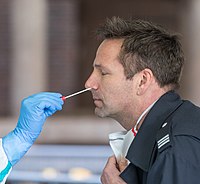Mahlahluvele ya COVID-19
Ku hlahluva vuvabyi bya COVID-19 swi hlanganisa ku kambisisa masalela lama tekiweke ku tiyisisa vukona bya xitsongwatsongwana xa SARS-CoV-2. Vuhlahluvi byi valanga vukona bya xitsongatsongana kumbe masocha ya miri lama tumbuluxiwaka hi miri endhzaku ko suleleka hi xitsongatsongwana.[1][2] Mbuyelo wa hlahluvo wa vukona bya xitsongwatsongwana switirhisiwa kutwisisa ku hangalaka ka vuvabyi lebyi naswona swi pfuna tindzawulo ta swa rihanyo ku landzelela lava suleriweke na ku sivela ku hangalaka ka ntungu. Kasi nhlanhluvo wa masocha ya miri wu hlamula xivutiso xa leswaku xana munhu u tshama a suleriwa hi vuvabyi bya khorona, kumbe e-e, hi swona leswi endlaka nhlahluvo lowu wunga tirhisiwi ngopfu hi kuva swi nga ha teka miri mavhiki yohlaya leswaku miri wu tumbuluxa masocha.[3]

Matiko yyo hambana-hambana ma tivumbelo milawu ya wona leyi lawulaka mahlahluvele ya vuvabyi lebyo, ku hlanganisa swikongomiso mayelana na lava vanga hlahluviwaka, makhambi yo thlela u hlahluviwa, ndlela yo kambisisa nhlahluvo, kuteka marha na matirhisele ya mbuyelo wa nhlahluvo.[4][5][6] Kuhambana loko ku hlohlotele tinhlayo ta ximfumo ta ku hangalaka ka vuvabyi lebyi, kuhlanganisa nhlayo wa lava hlahluviweke, lava khomiweke hi vuvabyi, lava dlaweke hi vuvabyi lebyi, kuhlanganisa na vuxokoxoko bya vavabyi.[7][8][9]
-
ku teka marhimila leswaku ma hlahluviwa vukona bya Khorona
-
ku teka marha ya nkolo leswaku ma hlahluviwa vukona bya Khorona
-
Muchini wo hlahluva vukona bya xitsongwatsongwana
Mintshaho
Lulamisa- ↑ CDC (11 February 2020). "Coronavirus Disease 2019 (COVID-19)". Centers for Disease Control and Prevention (in en-us). Retrieved 9 June 2020.
- ↑ Kobokovich, Amanda; West, Rachel; Gronvall, Gigi. "Global Progress on COVID-19 Serology-Based Testing". Johns Hopkins Center for Health Security (in English). Archived from the original on 9 June 2020. Retrieved 9 June 2020.
- ↑ "Test for Past Infection – CDC". CDC.gov. Centers for Disease Control and Prevention. 11 February 2020. Archived from the original on 16 May 2020. Retrieved 19 May 2020. "Antibody blood tests, also called antibody tests, check your blood by looking for antibodies, which show if you had a previous infection with the virus. Depending on when someone was infected and the timing of the test, the test may not find antibodies in someone with a current COVID-19 infection."
- ↑ Brotschi, Markus (7 March 2020). "Bund sucht nicht mehr alle Corona-Infizierten". Der Bund (in German). Retrieved 9 June 2020.
- ↑ Van Beusekom, Mary (24 March 2020). "Italian doctors note high COVID-19 death rate, urge action". CIDRAP News. Retrieved 9 June 2020.
- ↑ Otmani, Malin (22 March 2020). "COVID-19: First results of the voluntary screening in Iceland". Nordic Life Science – the leading Nordic life science news service (in en-US). Retrieved 9 June 2020.
- ↑ Ward, D. (April 2020) "Sampling Bias: Explaining Wide Variations in COVID-19 Case Fatality Rates". WardEnvironment. Digital object identifier: 10.13140/RG.2.2.24953.62564/1
- ↑ Henriques, Martha (2 April 2020). "Coronavirus: Why death and mortality rates differ". BBC News (in English). Retrieved 9 June 2020.
- ↑ "Why More Younger People Are Testing Positive for COVID-19". Time. Retrieved 2020-08-18.


